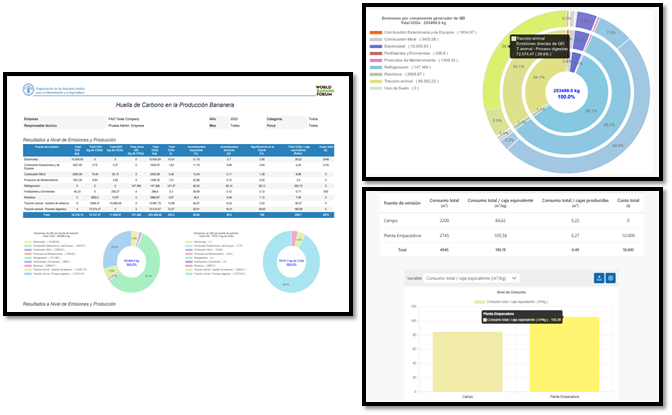Carbon and Water Footprint Tool
FAO supports countries and companies’ efforts to enhance climate change mitigation monitoring and evaluation (M&E) systems. These M&E systems allows stakeholders to make effective evidence-based decisions; reduce their impact and unlock additional investments for climate change mitigation in the agriculture and land use sectors.
Under this framework, The World Banana Forum has developed the Carbon and Water Footprint tool to support banana producing organizations in measuring and reducing its climatic impact.
The Carbon and Water Footprint Tool – CWF 2.0 is an automatic and user-friendly instrument to support banana production organization in calculating and reporting the carbon and water footprints of their operations.
Carbon and Water Footprint Tool Structure
The Carbon and Water Footprint Tool measures the Greenhouse Gas Emissions derived from farm operations and the impacts that the organization causes on water resources besides its consumption.
The version 1.0 of the tool was developed based on the Methodological Guide to Measure and Reduce Carbon and Water Footprints Banana Plantations and in alignment with the guidelines of the Intergovernmental Panel on Climate Change, Greenhouse Gas Protocol, ISO 14064, and ISO 14046.
The current version of the tool CWF 2.0 has received updates in its structure, features, and design, increasing its speed, computational power, customization, automatization, precision and user friendliness. The upgrades on the tool were based on the feedback of producers received during a validation process conducted in plantations in four countries of Latin America and the Caribbean.
Structure
The CWF tool is organized hierarchically with roles of general administrator and country administrator (both performed by FAO), company administrator and farm administrator. Each role has different functions and responsibilities on its own level.
Modules
The tool calculates the CO2 equivalent emissions (or removals) segregated by modules according to the different sources of emission: Electricity, Stationery and Equipment combustion, Mobile Combustion, Maintenance Products, Refrigeration, Fertilizers and Inputs, Residues, Animal Traction, Land Use Changes and Carbon Soil Stocks. Moreover, the tool is able to quantify the water footprint based on consumption and impacts associated with water scarcity human toxicity, ecotoxicity and eutrophication.
Customization
The CWF Tool provides to the user a list of the most used fertilizers and registered pesticides for bananas in the main producing countries. Moreover, allows the user to add its own fertilizer formulations, maintenance products, pesticides and equipment used in both, field and packing house.
Confidentiality
All the information inserted in the tool is strictly confidential under the regulations of the United Nations and only accessible to the Farm and Company administrators.
Results
The 2.0 version of the CWF Tool provides different sort of results to support the informed decision-making process of producing organizations in reducing its climate impact while optimising its processes and reducing costs.
The CWF Tool provides results at year, farm, and company levels in a myriad of dynamic tables and graphics that can be selected for the generation of automatic to support processes of compliance and certification. Moreover, the tool can be used as a permanent repository of the historical information and proof documents of farm/company operations related to the carbon and water footprints.
Finally, the tool helps banana producing companies to interpret, track and scale up ambition of their climate goals and inform stakeholders in a harmonized way.
Access to the tool
The Food and Agriculture Organization of the United Nations and the World Banana Forum Secretariat function as the creators and administrators of the credentials that enable access to the Carbon and Water Footprint tool to countries and companies.
Company administrators are responsible to assign farm administrators responsible for adding operational data, products, and updating the configuration tables within the tool. Additionally, company administrators can consult and download their results obtained per year, per farm or group of farms.
Contact |
|---|


